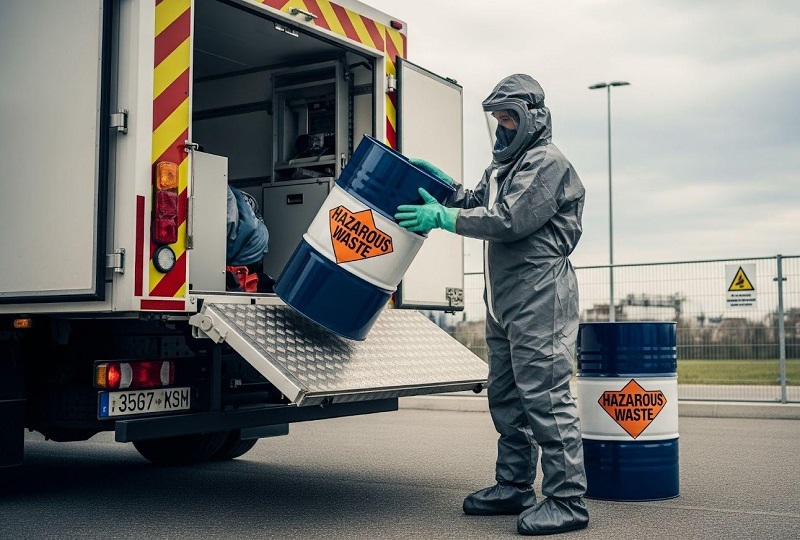The disposal of hazardous materials has become routine in industries, commercial organisations, and even residential areas today. Hazardous waste exists everywhere, from manufacturing plants and laboratories to hospitals to cleaning firms, and we must properly manage it.
Hazardous waste removal is not about disposing of undesired chemicals or any other material; it’s all about safety, care for the environment, and abiding by stringent legal legislation.
Professional hazardous waste removal services are indispensable to keeping people, businesses, and communities safe. Any toxic substance that is not handled correctly may pose serious health risks, contaminate the environment, and even lead to very expensive fines for failing to comply with existing regulations.
When organisations hire experts in hazardous waste removal, every step taken in waste collection, transportation, treatment, and disposal follows the highest standards of safety and legality.
In this blog, we’ll explore how professional waste removal companies operate, why compliance matters, and how they help maintain both safety and environmental responsibility.
Understanding Hazardous Waste and Its Risks
Before diving into the role of professional services, it’s important to understand what makes waste “hazardous.”
Hazardous waste refers to materials that pose a significant threat to human health or the environment.
- Flammable – Solvents, oils, or fuels
Toxic – Pesticides, heavy metals, and chemical residues - Corrosive – Strong acids or cleaning agents
- Reactive – Oxidisers or explosive compounds
Improper disposal of these materials can contaminate soil, water, and air. Exposure may also cause respiratory issues, skin irritation, or even long-term illnesses. This is why hazardous waste removal services are essential; they ensure these materials are managed, transported, and disposed of safely and legally.
The Importance of Compliance in Hazardous Waste Removal
One of the most critical aspects of hazardous waste removal is regulatory compliance. Governments and environmental authorities use strict guidelines for handling, storing, and disposing of hazardous materials. Businesses must follow such laws as the Environmental Protection Act and local waste management regulations.
Non-compliance can result in the following:
- Heavy fines and penalties.
- Legal consequences.
- Environmental damage and cleanup costs.
- Loss of public trust and reputation.
Professional hazardous waste removal services operate with a deep understanding of these regulations. Compliance through documentation, waste tracking, and disposal via certified processes will protect the environment and shield your business from liability.
How Professional Hazardous Waste Removal Services Work
Hiring a professional waste removal company doesn’t just involve getting rid of unwanted materials. Here’s a simple look at how the process usually works from start to finish.
1. Identifying and Classifying the Waste
The team assesses the waste before moving anything. They examine and classify each material. This is based on its physical and chemical properties. This step is important. It determines safe handling, transport, and disposal of the waste.
2. Safe Collection and Containment
They collect and place the identified waste into approved, labelled containers. This prevents mix-ups. They seal each container to prevent spills or leaks. Workers wear personal protective equipment (PPE). This ensures a safe working environment. It also protects them from hazards.
3. Transporting the Waste
After containment, licensed vehicles transport the waste. These vehicles comply with all regulations. They have safety features for emergencies and leaks. The goal is to move the waste efficiently and safely. This protects people and the environment.
4. Treatment and Final Disposal
At a certified facility, the waste undergoes treatment to make it safe for disposal or reuse. The facility might use different methods based on the material.
- Incineration of chemical or biological waste
- Neutralisation of acids and bases
- Recycling or recovery of metals and solvents
- Secure landfilling of anything that can’t be reused or treated further
The team chooses each approach carefully to minimise environmental impact and ensure full compliance with legal standards
5. Documentation and Reporting
Once the job is complete, the company provides detailed paperwork such as waste transfer notes and certificates of destruction. The records are also important for environmental reporting, audits, and in proving responsible handling throughout.
Choosing the Right Service Provider
Selecting a reliable partner for hazardous waste removal is key to maintaining safety and compliance. Here’s what to look for when choosing a provider:
- Licensing and Certification – Ensure the company is certified to handle and transport hazardous materials.
- Experience and Reputation – Look for proven expertise in managing your industry’s specific waste types.
- Transparency – A good provider offers clear documentation, transparent pricing, and open communication.
- Comprehensive Services – Choose a company that handles everything from identification to disposal.
- Environmental Commitment – Select a service that follows eco-friendly and sustainable practices.
By choosing the right partner, businesses can reduce risk, improve compliance, and demonstrate environmental responsibility.
In Conclusion
Proper hazardous waste removal is much more than a regulatory requirement; it is actually a commitment to people, the environment, and the reputation of your business. Professional hazardous waste removal services come equipped with the knowledge, equipment, and processes that ensure safe handling, compliance with legislation, and environmentally friendly disposal of harmful materials.
By trusting experts in hazardous removal, you can be assured that every step of the process-from collection to disposal done in an environmentally responsible manner. In this manner, your company also avoids fines and health hazards, while contributing to a cleaner, safer, and more sustainable future for all.






